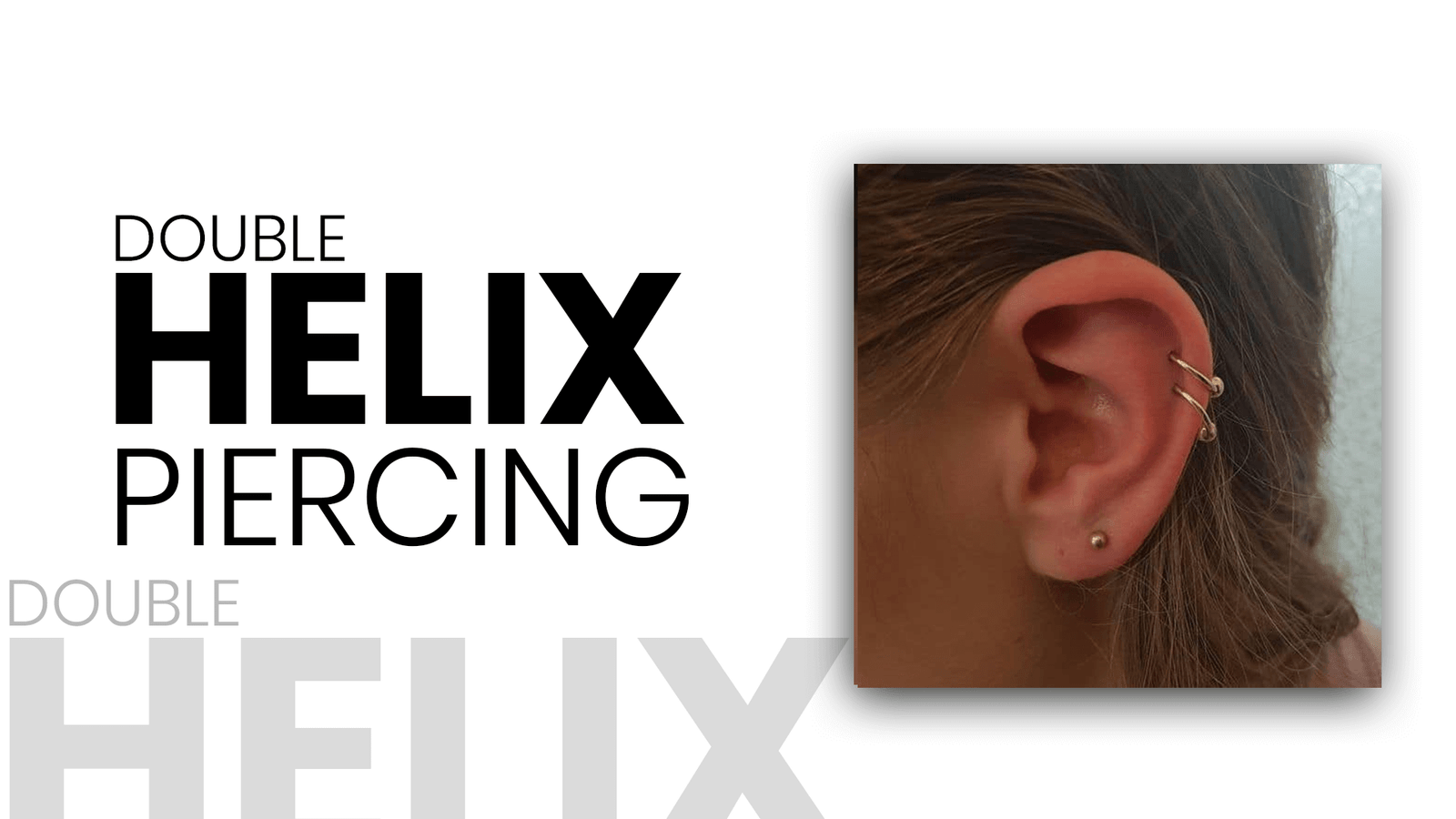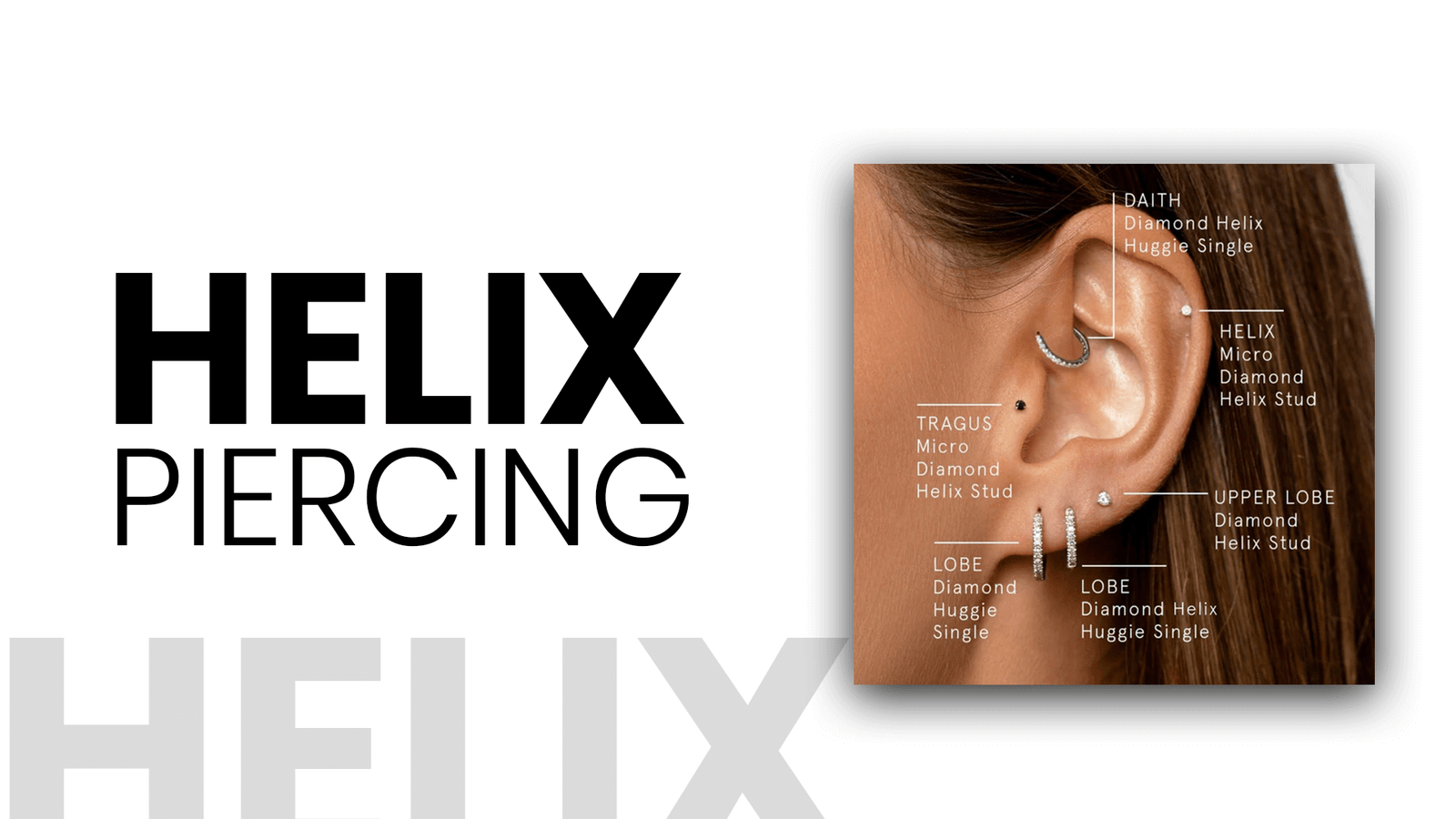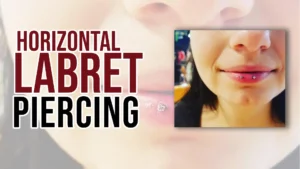Do you want to give your look a little edge without going overboard? The perfect piercing for you might be a helix one! This fashionable piercing lies on the ear’s outer rim, giving the wearer a demure yet eye-catching appearance that may be easily accessorized with hoops or studs. People of all ages and genders have taken up helix piercing as a distinctive form of self-expression in recent years.
A helix piercing is a versatile and fashionable option whether you want to add a little rebelliousness to your business dress or change your everyday appearance. To securely wear this trendy addition, we’ll cover everything you need to know about helix piercings in this post, from the healing process to the best jewelry selections. So, are you prepared to pierce your helix and become a club member? Let’s start now!
What is Helix Piercing?
You likely picture the widely recognized helix piercing when considering a cartilage piercing. It’s simple to mistake the helix piercing for other piercing kinds, such as the auricle or conch cartilage piercings because it’s located in the upper cartilage of the ear. You should carefully consider where you want your helix piercing to be situated before seeing your piercer because your upper cartilage provides a large playground for piercings. Although your piercer can assist you, the location of your helix piercing will ultimately depend on your preferences.
While ear piercings typically heal quickly, cartilage heals differently than softer skin, so you must follow all instructions carefully to prevent issues. Mainly the ear cartilage is prone to unusual scarring, and in severe cases, damage from a cartilage piercing can result in permanent ear deformities, such as cauliflower ear. Don’t let this make you afraid of getting this adorable piercing! Here is all the information you require on the helix piercing.
Forward Helix Piercing

What distinguishes a forward helix piercing from a backward one, first and foremost? It’s relatively easy: follow your cartilage’s natural curve around your ear until you reach the side of your face (i.e., just above the tragus), where there is a forward helix piercing. Additionally, double or triple-forward helix piercings are options.
Double, Triple & Quadruple Helix Piercing

A popular piercing is the double, triple, or even quadruple helix. As you would infer from the name, these designs include several helix piercings along the ear. To create a long chain of jewelry that extends the entire ear length, some people connect several helix piercings with auricle, upper lobe, and forward helix piercings.
The number of piercings you can get along your cartilage is unlimited; ensure there is enough room between each one to allow for safe jewelry replacements without compromising the ear’s structural integrity. It’s a good idea to get each piercing separately if you want many so that you only have to worry about one piercing at a time needing to heal.
Anti-Helix Piercing
The snug, another name for the anti-helix piercing, is located just inside the ear, not on the outer edge like typical helixes do.
Pain Level of Helix Piercing
In general, cartilage piercings are not particularly painful. Depending on where the helix piercing is located, you may have a tiny pinch, but nothing more than that. The helix-piercing location has fragile cartilage. Therefore, the procedure is completed rapidly. After the piercing, you may have aching, swelling, and minimal bleeding for a few days.
These symptoms are usually in moderation. Consult a doctor if you have these symptoms frequently. It’s crucial to watch your cartilage piercing while it heals and prevents you from adjusting the jewelry since cartilage piercings are prone to issues, including cartilage bumps. Unlike soft skin, cartilage heals differently, and healing can readily cause injury.
Healing Time of Helix Piercing
The average healing period is 12 weeks or more, but this can vary from person to person. It is advised to wait until the piercing has fully healed before switching out your jewelry. If you don’t, it can significantly slow down the healing process. It shouldn’t be agonizing, sore, or weeping when it’s time to change. Wait if it is. There is still time to include lovely jewelry.
Things to do during Healing Process
Here are some activities you can engage in while your helix piercing is healing:
- Use a saline solution or moderate, fragrance-free soap and water to wash the piercing twice daily.
- Please refrain from contacting anything with unclean hands or letting anyone else touch it.
- Avoid sleeping with the piercing on your side for the first few weeks.
- Till the piercing is completely healed, stay out of lakes, hot tubs, and pools where you could swim or soak.
- Be careful not to use strong chemicals or hair treatments that could contact the piercing.
- Do not wear clothing or accessories that are too tight and might rub against the piercing.
- Till the piercing is entirely healed, refrain from switching out the jewelry.
- It would be best not to use ointments and creams on the piercing since they can trap bacteria and slow healing.
Adhering to these recommendations can encourage recovery and lower the risk of infection or other consequences. Get immediate medical assistance if you experience infection-related symptoms, including redness, swelling, or discharge.
Cost of Helix Piercing
Your helix piercing will cost you $40 to $50. A piercing gun at a store will cost around $20, but we do not recommend it. Never get any piercing done by someone who uses a piercing gun. Never, ever, ever, ever choose a piercing gun for cartilage piercings. Blunt force trauma to the cartilage is what causes problems like cauliflower ears.
Blunt force trauma is defined as when the piercer forces the jewelry through the piercing with a piercing gun. Furthermore, piercing guns are more bacterially contaminated than needles. You must use a needle if you want your cartilage to repair happily.
Jewelry for Helix Piercing
It’s time to daydream about the jewelry you’ll wear once you’re well enough to wear it once we’ve sufficiently frightened you into following aftercare procedures. The position of the helix piercing provides for a ton of gorgeous jewelry designs, and the piercing itself allows for unlimited individuality.
Helix Earrings
Helix earrings are earrings that are flawlessly designed to fit the place on the ear.
Stud
A straight stud is a sweet, understated way to adorn your helix piercing. The top of your ear is adorned with tiny gemstones for a sparkling but understated flare. Additionally, you can display your personality with adorable charms. You can choose a ball back to decorate both sides of the ear or a flat disc back for a less clear backing.
Labrets
Popular stud earrings with a flat back are called labrets. Most labrets have delicate designs, solid 14-karat gold and solid 14-karat white gold.
Captive Bead Rings
Rings with captive beads look amazing in the helix piercing as well. When you combine a hoop and bead, the best of both worlds is achieved. Choose from colorful bead options like opals, Baltic amber, pearls, or a straightforward metal bead.
Huggies Earrings
Huggie earrings are tiny hoops frequently adorned with brilliant diamonds for extra glitz. The small rings will encircle the ear’s outer edge.
Hoop Earrings
Among the most popular helix jewelry designs are hoop earrings. For a clean, understated appearance, seamless hoops work well. This design is popular among those with several ear piercings since it balances off the surrounding jewelry without being too heavy. Additionally, clickers and segment rings provide a seamless appearance in a jewelry design that is simpler to put in the ear.
Barbells
Barbells that are curved and round are also excellent choices for helix piercings. These are popular trends among those who wear various bead jewelry designs in their ears.
Ear Cuffs
Only cartilage piercings can use ear cuffs. They offer a style comparable to the hoop since they wrap around the ear but are frequently thicker and more elaborate.
Cartilage Shields
More oversized jewelry items called cartilage shields usually serve as the focal point of your ear jewelry. These gorgeous accessories hang from the ear’s side, protecting a significant amount of your cartilage.
How to Clean your Jewelry?
You’ll require a plastic container (ideally a small bowl or tub), a little aluminum foil, a water-boiling kettle, and a few teaspoons of baking powder or bicarbonate of soda. Follow the given steps to clean your jewelry:
- The foil is facing up with its shiny side out.
- Make sure your jewelry touches the foil as you place it in the tub.
- Make sure the jewelry is completely submerged by pouring hot water over it.
- Add baking powder or bicarbonate of soda, about 2 tbsp per liter of hot water.
- Allow it to bubble and fizz; you might see that the tarnish begins to remove and the lovely sparkle beneath emerges.
- You should repeat the procedure several times if the piece is tarnished.
- To avoid burning yourself, wait 10 minutes before removing the jewelry from the tub using a spoon.
- Apply some paper kitchen towel on the jewelry to help it dry.
Conclusion
In conclusion, a helix piercing is a fantastic option if you’re considering getting a new piercing. It’s understandable why this piercing has grown in popularity over the past few years, given its adaptability and limitless styling options.
The helix piercing is an excellent option for adding something basic and understated to your ear or for an intense and dramatic design. Remember to take good care of your piercing and follow your piercer’s aftercare instructions to guarantee a rapid and comfortable healing process. You’ll soon be rocking your new helix piercing with perseverance and care!





